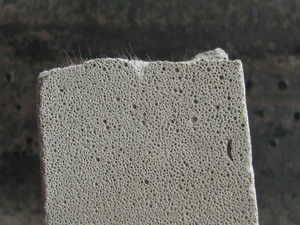 Dr.
Aleksandr
Novytskyi
Processing of rock
basalt types in
different types of
fiber, a personal
information site
Dr.
Aleksandr
Novytskyi
Processing of rock
basalt types in
different types of
fiber, a personal
information siteUse of basalt fibers in bituminous mastics
Bituminous mastic is a homogeneous mass of bitumen, dust or fibrous fillers
(limestone, dolomite, quartz powder, talc or asbestos 7th grade, mineral wool),
preservatives and additives.
Fillers can reduce the consumption of bitumen and its fragility, to improve
heat resistance.
Hot bitumen roofing mastic brands MBK-G-55, MBK-G-65, MBK-G-75, MBK-G-85,
MBK-G-100 (letters indicate the abbreviated name of mastic, and the numbers -
its heat resistance) is prepared by heating the bitumen
up to 160 - 180 oC, which is introduced into the filler and additives.
Cold bituminous mastics consist of a mixture of bitumen, solvent (solar oil,
kerosene), a filler and an antiseptic.
Due to the presence of solar oil capable of dissolving the bitumen and to seep
into the rolled material, the mastic does not need to warm up, they are well
adhered to each other and glued to the bottom of the roof membrane elements.
Cold bituminous mastics are designed for device multilayer roofing for hydraulic
and vapor barrier.
The most common is mastic MBK-X-1.
Wood
tar mastic consists of tarry binder and filler.
Producing hot wood tar mastic MDC-T-50, MDC-T and MDC-60-G-70, which are used
in the production of roofing and waterproofing works (cold areas).
The device is waterproof laminated carpet is not required for so-called "without
roll
roofs."
To these may be used cold asphalt mastic (with lime emulsifier) consisting (by
weight) of the emulsion - 50, dusty filler (limestone, dolomite, cement dust,
brick) - 35, fibrous fillers such as asbestos, phenol, mineral fibers 3
-persent solution of sodium fluoride - 5 Water - 10. The emulsion contains 57%
bitumen, 5 - 8% stillage, 36 - 38% water.
There is a bitumen-rubber mastic cold, composed of bitumen III - 35 - 45% crumb
rubber - l5 - 20% of the solvent is white spirit - 30 - 40% filler - fibre- 10 -
15%.
This paste can be transported through the pipeline ..
Basalt fiber as the filler can improve the mechanical properties of the mastic
to prevent the formation of cracks in the coating during the cold season, reduce
flow mastic when exposed to heat.
Fibres hardly stretched, pores on the surface of the fibers are filled, thereby
creates reinforcement coating.
Basalt rock is alkaline, so you need to use for the production of mastic anionic
bitumen emulsions.
When applied specifically introduced surfactants (surfactant) should be borne in
mind that certain carriers bitumens are oxygen, sulfur and nitrogen compounds,
which act as surfactants.
Because the bitumen present in the surfactant preferably of anionic type
chemisorption
processes are possible only on the surface of mineral materials containing
oxides of alkaline earth and heavy metals.
On the surface of the mineral materials are usually acidic rocks adsorption is
physical in nature.
The positive charge of the surface of the main species of mineral materials
favors the adsorption of anionic surfactants, but it is not always positively
charged.
Adsorption processes and molecular surface phenomena related to the adsorption
of surfactant, change the structure of the boundary layers of bitumen and affect
the properties of bituminous mixtures.
Anionic surfactants provide good adhesion when formed soap sparingly.
It is found that the carboxyl compound fixed on the surface of the minerals in
the molecular, and in ionic form.
Therefore is essential pre-activation of the mineral surface.
Introduction of surfactants improves the adhesion of the bitumen to the
mineral constituents, to improve their processability.
The
Earth's crust is 80% of the basalt rock.
Millions of years, this material has lain in the ground while maintaining their
properties, which suggests its durability and environmental friendliness.
Production of roofing mastics using basalt fibers little practiced in the
absence of the latter in the construction market.
But recently, the production of the fibers was intensively developed that
provides reliable on their wider use.

Some aspects of the technological process of CBF
Production of continuous basalt fiber based on the melting in the furnace crushed basalt, followed by stretching of the resulting melt filaments. The formation of filaments through holes in the bushing....
Read more
Technology of production continuous basalt fiber
Planet earth has rich deposits of a variety of natural stone materials, the outputs of which the surface is very beautiful and sometimes unique geological monuments of history...
Read more
Concrete reinforced with basalt fibers
At present, it has developed two directions of creation of composite materials: - Composites high modulus fibers (steel, asbestos, glass, basalt); - Composites low modulus fibers (nylon, polyethylene, polypropylene ....
Read more



